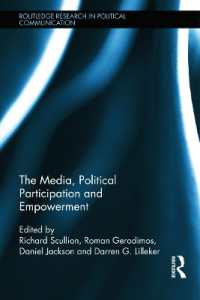Full Description
In schools, a Code Red alert indicates a potential or immediate threat within a building or on a campus and is the signal for a full-scale lockdown of all classrooms. This book, Code Red: Conversations and Solutions for an Educational System in Crisis, presents a variety of voices from teachers, administrators, teacher preparation faculty, college supervisors, and pre-service teacher candidates. These voices are crying "Code Red" because they want a broken system repaired. For them, the system is bleeding, cancerous, and in turmoil, with the expectation that they work under arduous and often dangerous conditions; teachers are underpaid, devalued, exhausted, voiceless, and abused. They face an environment in which politics has replaced learning, students are failing and, in extreme circumstances, walking away from schools or even committing suicide. The political discourse is wrestling control from teachers in certain states. Neurodivergent students are being pushed aside. The altruistic profession of teaching is being reduced to factory work, in which teachers--especially those in their first five years of service--are leaving the profession at staggering rates. The profession itself is at risk of becoming obsolete.
The contributors to Code Red believe that the American educational system has entered a moment of crisis. Their voices need to be heard, and their stories and lived experiences should be recognized. The adage is true: the answer to any problem resides with those who own the problem. We cannot create solutions without owning that these issues exist, and all of America owns the education of our children. Therefore, this book provides a dialogic space where everyone involved in the American educational system can reimagine the possibilities of our system and, through this process, begin creating positive and sustainable changes to bring our system out of crisis. In addition to providing a vivid picture of the current state of public schools, the book offers real solutions that can be used to produce healthier, more successful classrooms. It is an invaluable tool for instructors, pre-service teachers, and Colleges of Education administrators.
Contents
Introduction by Anna Dunlap Higgins-HarrellPart I
Chapter 1Code Red by Joseph R. Jones
Chapter 2"We Don't Talk about Bruno:" Seeing the Needs of Our Neurodivergent Students and Their Families by Lindsay Tisdale Harrell
Chapter 3Trauma-Informed Colleagues by Jennifer Medgull
Chapter 4Paper and Pencil, The Building Blocks of Learning by Rebecca Doyle
Chapter 5Speaking a Truth: Interview with a Veteran Educator by Joseph R. Jones
Chapter 6Teachers Have Lost Their Voices by Michael Jeffcoat
Chapter 7A Voice from the Field by Anna Dunlap Higgins-Harrell
Chapter 8Technology and Its Effects on Student Behavior by Jadziah Ogletree
Chapter 9From Chemist to Educator: Navigating an Unconventional Path to Education Innovation by Tenecia Powe
Chapter 10No Longer Part of the Problem by Jessica Traylor
Chapter 11Nobility and Salaries: A Reciprocity of Value by Joseph R. Jones
Chapter 12So, You're a New Teacher: Bless Your Heart! by Julie Little and Randall Brookins
Part II
Chapter 13Creating Professional Learning Opportunities for Our Teachers by Noah Lawton Harrell
Chapter 14
Tough Customers by Emily Salmon
Chapter 15If You Watch Sports, Then You Want Instructional Coaches by Jennifer Medgull
Chapter 16All In and Burned Out: Why Principals Are Leaving by Adam Dovico
Chapter 17Instruction, Identity, and Inclusivity: What Can Teacher Preparation Programs Learn from Gay Male Teachers in the South? by Joseph R.Jones
Chapter 18Superhumans: Student Teachers in a Time of Crisis by ErinnBentley
Chapter 19Promoting Student Engagement and Enhancing Outcomes Through CommunityInvolvement by Noah Lawton Harrell
Chapter 20Pressing Issues and Contemporary Concerns by Fran Dundore
Chapter 21Violence in Schools by Forrest R. Parker III
Chapter 22Recruiting Teacher Candidates from Marginalized Groups by Stephen Raynie
Chapter 23From Great Challenge Comes Great Gain: Promoting Collaborative Planning in K-12 Schools by Noah Lawton Harrell
Chapter 24Schools in Crisis: The Importance of Social-Emotional Learning in the Lives of Rural Middle School Students by Kraig Howell
Chapter 25The Unique Needs of Generation Z in the Educational Work Environmentby Nila Burt and Joseph R. Jones
About the Authors
Index








